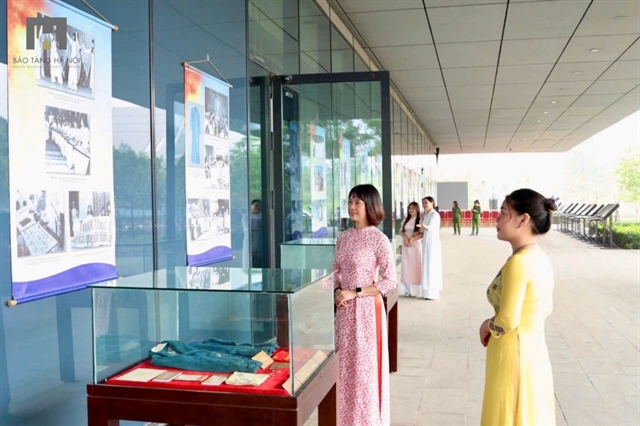More than a garment, the áo dài serves as a silent witness to the bravery, sacrifices and unwavering determination of Vietnamese women during the country’s struggle for independence and national defence.

The áo dài is not only a cultural piece and a sophisticated piece of clothing, but also preserves stories of love, history and a deep longing for national spirit and identity. Photos vov2.vov.vn
HÀ NỘI -- The Hanoi Museum, in collaboration with the War Remnants Museum and the Mind Group Co., Ltd., has launched a special exhibition titled 'Vietnamese women's áo dài through the fires of war' in commemoration of the 50th anniversary of the Liberation of the South and National Reunification Day.
This exhibition takes visitors on a powerful journey back in time, spotlighting the iconic áo dài (Việt Nam’s traditional long dress) as a symbol, not only of cultural elegance, but also of resilience and patriotism. More than a garment, the áo dài serves as a silent witness to the bravery, sacrifices and unwavering determination of Vietnamese women during the country’s struggle for independence and national defence.
By showcasing the áo dài in its wartime context, the exhibition honours the countless mothers and sisters who devoted their youth, their intellect and, in many cases, made the ultimate sacrifice for their homeland. Each photograph, document and artefact on display tells a vivid and emotional story about the indomitable spirit of Vietnamese women.
Throughout the bombings and chaos of war, the áo dài remained present on the streets during demonstrations for democracy and civil rights, and accompanying young female students who took to the frontlines of protest. In a time when weapons of resistance were not only bullets and bombs but also moral conviction and unshakable will, the image of women in áo dài emerged as a potent symbol of strength and unity.
The áo dài featured prominently in political movements, at international forums and diplomatic conferences, worn by female Vietnamese leaders who captured global attention. These women, graceful in appearance but steely in resolve and sharp in reasoning, played a key role in garnering international support for Việt Nam’s revolutionary cause. The áo dài became an inseparable companion to the nation’s women, contributing to the historic victory of the Spring Offensive in 1975 and the reunification of the country.

The exhibition provides visitors with a deeper understanding of the tremendous contributions Vietnamese women made in defending the nation.
The exhibition displays over 100 pieces, including photographs and physical artefacts, illustrating how the áo dài was worn by heroic women both on the battlefield and on the diplomatic front. Among the most moving exhibits are personal belongings of wartime heroines, such as martyr doctor Đặng Thùy Trâm and Dương Thị Quý, handwritten volunteer applications to join the front lines, letters and keepsakes, tinged with the patina of time and memory.
“The áo dài is not only a cultural icon or a sophisticated piece of clothing, but also preserves stories of love, history and a deep longing for national spirit and identity,” said Đặng Văn Biểu, deputy director of the Hanoi Museum, at the exhibition's opening.
“Today, the áo dài continues to embody the enduring vitality, courage and spirit of the Vietnamese people throughout history,” he added.
Through its powerful narrative and message — 'Cherish, preserve, and promote the cultural heritage of the Vietnamese áo dài' — the exhibition provides contemporary audiences with a deeper understanding of the tremendous contributions Vietnamese women made in defending the nation. Simultaneously, it celebrates the enduring cultural value of the áo dài as a timeless national symbol.
The exhibition runs until May 4, at the Hanoi Museum, promising visitors a meaningful experience that reconnects the past with the present and illuminates the legacy of Vietnamese women through the graceful yet resilient folds of the áo dài. -- VNS